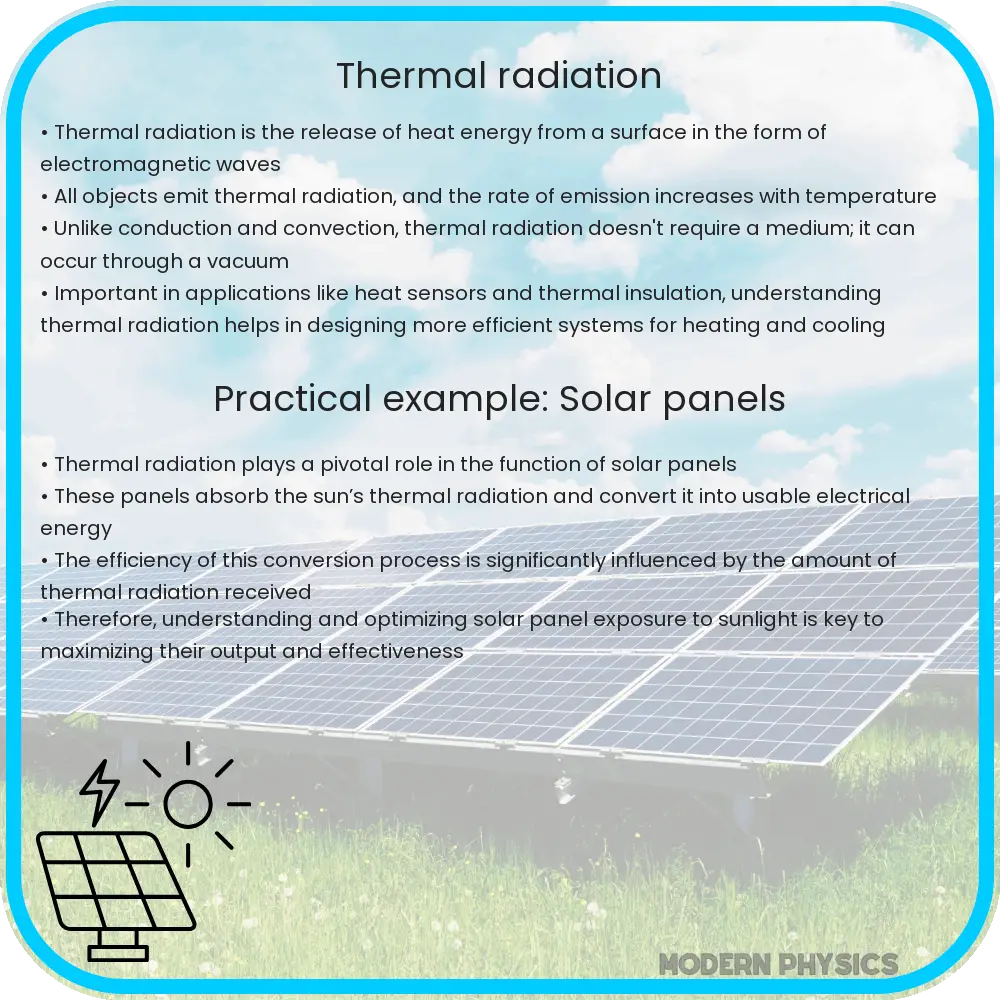Explore the fundamentals and applications of thermal radiation, from basic principles to advanced technological uses and environmental impacts.

Understanding Thermal Radiation
Thermal radiation, a fundamental concept in physics and engineering, refers to the emission of electromagnetic waves by all objects with a temperature above absolute zero. This phenomenon is rooted in the vibrational and rotational motion of atoms and molecules, which results in the emission of energy in the form of electromagnetic radiation.
Basic Principles of Thermal Radiation
At the core of thermal radiation are two key principles: Planck’s Law and the Stefan-Boltzmann Law. Planck’s Law describes the spectrum of radiation emitted by a body, asserting that each frequency of radiation is emitted with a specific intensity that depends on the temperature of the body. The Stefan-Boltzmann Law, on the other hand, quantifies the total energy radiated per unit surface area of a black body per unit time. It is expressed as E = σT4, where E is the emissive power, σ (sigma) is the Stefan-Boltzmann constant, and T is the absolute temperature in kelvins.
Applications of Thermal Radiation
- Energy Production: Thermal radiation principles are integral in solar panel technology, where solar energy is converted into electrical energy. Understanding thermal emission helps in optimizing the efficiency of these panels.
- Thermography: In medical and industrial fields, thermal cameras utilize thermal radiation to detect heat patterns or temperature changes, useful in diagnosing diseases or inspecting electrical equipment.
- Climatology: Earth’s climate system is influenced by thermal radiation, particularly in the context of the greenhouse effect. Studying thermal radiation aids in understanding and modeling climate change.
These applications underscore the importance of thermal radiation in a variety of sectors, making it a pivotal topic in scientific and engineering disciplines.
Conclusion
In the next section, we will delve deeper into the mathematical models governing thermal radiation, explore more of its real-world applications, and discuss the latest technological advancements in this field.
Mathematical Modeling of Thermal Radiation
The mathematical models for thermal radiation provide a quantitative framework for understanding and predicting the behavior of radiative heat transfer. Two essential models are Wien’s Displacement Law and Kirchhoff’s Law of Thermal Radiation. Wien’s Law states that the wavelength at which the radiation from a black body is maximum inversely correlates with its temperature, following the equation λmax = b/T, where λmax is the peak wavelength, b is Wien’s displacement constant, and T is the temperature in kelvins. Kirchhoff’s Law posits that at thermal equilibrium, the emissivity of a body (its ability to emit radiation) equals its absorptivity (ability to absorb radiation).
Advanced Applications in Technology
Thermal radiation has advanced applications in cutting-edge technologies:
- Space Exploration: Spacecraft and satellites use thermal radiation principles for temperature control, utilizing materials with specific emissivity properties to maintain optimal operating conditions.
- Energy Efficient Buildings: Architects incorporate knowledge of thermal radiation to design buildings that optimize energy use, using materials that reflect or absorb thermal radiation effectively.
- Scientific Instruments: Devices like spectrometers and telescopes rely on understanding thermal radiation for accurate measurement and observation of distant stars and galaxies.
Environmental Impact and Future Prospects
Thermal radiation also plays a crucial role in addressing environmental concerns. For example, improving the efficiency of thermal radiation management in industrial processes can significantly reduce energy consumption and greenhouse gas emissions. Looking forward, advancements in nanotechnology and materials science promise even more efficient and diverse applications of thermal radiation, potentially revolutionizing sectors like renewable energy, environmental monitoring, and thermal imaging.
Conclusion
Thermal radiation, an intrinsic property of all matter with temperature, finds its significance in a myriad of applications, from everyday technologies to advanced scientific research. Its principles not only enhance our understanding of the natural world but also drive innovation in various fields. As technology progresses, the study and application of thermal radiation will continue to play a pivotal role in shaping a sustainable and technologically advanced future.
